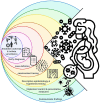The perinatal health challenges of emerging and re-emerging infectious diseases: A narrative review
- PMID: 36684933
- PMCID: PMC9850110
- DOI: 10.3389/fpubh.2022.1039779
The perinatal health challenges of emerging and re-emerging infectious diseases: A narrative review
Abstract
The world has seen numerous infectious disease outbreaks in the past decade. In many cases these outbreaks have had considerable perinatal health consequences including increased risk of preterm delivery (e.g., influenza, measles, and COVID-19), and the delivery of low birth weight or small for gestational age babies (e.g., influenza, COVID-19). Furthermore, severe perinatal outcomes including perinatal and infant death are a known consequence of multiple infectious diseases (e.g., Ebola virus disease, Zika virus disease, pertussis, and measles). In addition to vaccination during pregnancy (where possible), pregnant women, are provided some level of protection from the adverse effects of infection through community-level application of evidence-based transmission-control methods. This review demonstrates that it takes almost 2 years for the perinatal impacts of an infectious disease outbreak to be reported. However, many infectious disease outbreaks between 2010 and 2020 have no associated pregnancy data reported in the scientific literature, or pregnancy data is reported in the form of case-studies only. This lack of systematic data collection and reporting has a negative impact on our understanding of these diseases and the implications they may have for pregnant women and their unborn infants. Monitoring perinatal health is an essential aspect of national and global healthcare strategies as perinatal life has a critical impact on early life mortality as well as possible effects on later life health. The unpredictable nature of emerging infections and the potential for adverse perinatal outcomes necessitate that we thoroughly assess pregnancy and perinatal health implications of disease outbreaks and their public health interventions in tandem with outbreak response efforts. Disease surveillance programs should incorporate perinatal health monitoring and health systems around the world should endeavor to continuously collect perinatal health data in order to quickly update pregnancy care protocols as needed.
Keywords: communicable disease; disease outbreak; emerging infectious disease; perinatal health; public health surveillance; re-emerging infectious disease.
Copyright © 2023 Malange, Hedermann, Lausten-Thomsen, Hoffmann, Voldstedlund, Aabakke, Eltvedt, Jensen, Breindahl, Krebs, Christiansen and Hedley.
Conflict of interest statement
Author PH held an unpaid position at Brazen Bio. The remaining authors declare that the research was conducted in the absence of any commercial or financial relationships that could be construed as a potential conflict of interest.
Figures

References
-
- van Seventer JM, Hochberg NS. Principles of infectious diseases: transmission, diagnosis, prevention, and control. Int Encyclopedia Public Health. (2017) 22–39. 10.1016/B978-0-12-803678-5.00516-6 - DOI
-
- Morse SS. Factors in the emergence of infectious diseases. In:Price-Smith AT, editor. Plagues and Politics. London: Palgrave Macmillan; (1995). p. 8–26.
-
- Roser M, Ritchie H. Burden of disease. Our World in Data. (2016).
Publication types
MeSH terms
LinkOut - more resources
Full Text Sources
Medical
Miscellaneous

